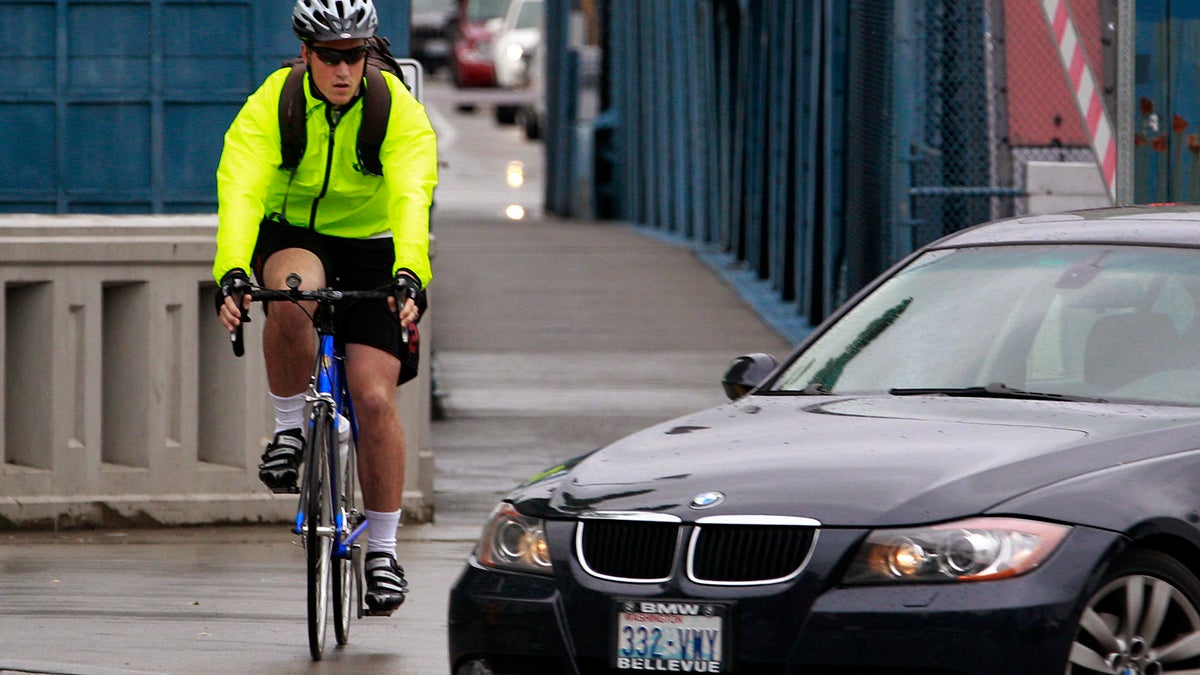Ideas Worth Stealing: Cycling safety beyond bike lanes

A bicyclist commuting during rush hour keeps an eye on a car turning in front of him in Seattle, Washington. (AP File Photo/Elaine Thompson)
As cities ramp up biking infrastructure and programs, there’s still more they can do to make biking safe.
Ideas Worth Stealing: Every week, Keystone Crossroads will look to cities across the world for lessons in urbanism and municipal governance that could benefit Pennsylvania. No city does it all right, and we hope these examples from metropolises near and far inspire and encourage cities here to think outside the box.
If you use a bicycle to get around town, chances are you’ve gotten frustrated asserting your right to be on the road and to feel safe while riding.While drivers complain that cyclists weave unpredictably and take up room on backed up, narrow streets, cyclists gripe that drivers speed or don’t keep sufficient distance from them, making biking a dangerous, stressful way to get around. And, cyclists add, even when a street has a bike lane, cars often park in it or the lane is otherwise blocked. Unsafe biking conditions could discourage new cyclists or, worse, lead to tragic accidents (there is no conclusive data on who is more likely to cause car-bike collisions, the driver or the cyclist).
U-Lock Justice — when cyclists address their grievances with a bike lock through the windshield — is one approach to dealing with drivers, but it would probably be better for everyone involved if they just followed the rules. But how to enforce that? One obvious answer is that police officers could be more proactive. But they are usually in a cruiser, which gives them a completely different perspective from a cyclist. Resources are limited at many police departments, too. Still, as cities build up cycling infrastructure and ramp up their cycling programs, some have started addressing issue of bicycling safety beyond bike lanes. That includes enforcement of existing rules meant to protect cyclists, and even strengthening laws.
In a Houston pilot program, the police department put plainclothes officers on bicycles. The officers could better tell whether drivers were passing too closely to cyclists when they themselves were the cyclists. There’s also a pretty cheap device, called BSMART, that reads the distance of a passing vehicle from a bike. The device can attach to a police bike’s handlebars and it beeps when a car gets too close to a bike, recording what it sees. Think of it as a speed radar gun, but for distance.
In Washington, D.C., the police department runs an extensive automated traffic enforcement program. With not enough money to put sufficient ticketing officers on the ground, the department is instead relying on cameras to ticket drivers who are speeding, not stopping at stop signs or pedestrian crosswalks, or blocking intersections. The program is a response to surveys that identify aggressive driving as a big concern for D.C. residents.
And since rules are always less effective than ingrained attitudes, cities like Pittsburgh are also waging heartfelt campaigns reminding drivers to slow down because, you know, people on bikes are people, too. (Unfortunately, many of the posters appear in bus shelters and on buses — probably not the most visible places for drivers.)
Enforcing the laws we have — like the Pennsylvania law that requires drivers to leave four feet between the car and a cyclist when passing — is one thing, but the laws themselves can also be better. Cities can pass ordinances upping fines for parking in bike lanes or make more rules about how to safely pass a biker. Still, that comes back to enforcement.
Unless of course lawmakers really go big: in the Netherlands, for example, in a collision, the law assumes it’s always the driver’s fault unless the driver can prove no part of the accident is his fault. The Dutch see cyclists and pedestrians as the weaker road users, needing extra protection from the stronger cars. The idea is that such a strict liability law leads drivers to operate more carefully, not because they might get a nominal fine, but because if anything happens they’re almost always responsible, which can be a whole lot more expensive than a fine. As long as someone is there to take down a report after a crash, enforcement becomes a moot point.
WHYY is your source for fact-based, in-depth journalism and information. As a nonprofit organization, we rely on financial support from readers like you. Please give today.


